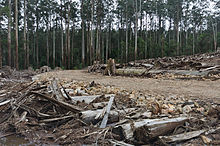- Corduroy road
-
 In war, corduroy roads are often used as an emergency measure where bad-quality roads have been damaged by the large numbers of vehicles or troops that have passed over them. Seen here are Germans in Yugoslavia in 1944.
In war, corduroy roads are often used as an emergency measure where bad-quality roads have been damaged by the large numbers of vehicles or troops that have passed over them. Seen here are Germans in Yugoslavia in 1944.
A corduroy road or log road is a type of road made by placing sand-covered logs perpendicular to the direction of the road over a low or swampy area.
The result is an improvement over impassable mud or dirt roads, yet rough in the best of conditions and a hazard to horses due to shifting loose logs. This type of road was constructed in Roman times. It is known to have been used as early as 4000 BC with examples found in Glastonbury, England.[1] Compare the puncheon or plank road, which uses hewn boards instead of logs, resulting in a smoother and safer surface.
Corduroy roads can also be built as a foundation for other surfacing. If the logs are buried in wet, acidic, anaerobic soils such as peat or muskeg they decay very slowly. A few corduroy road foundations that date back to the early 20th century still exist in the United States.[citation needed] One example is the Alaska Highway between Burwash Landing and Koidern, Yukon, which was rebuilt in 1943, less than a year after the original route was graded on thin soil and vegetation over permafrost, by using corduroy, then building gravel road on top. During the 1980s, the gravel was covered with a chip-seal. The late 1990s saw replacement of this road with modern road construction, including rerouting of the entire highway.[citation needed]
 Excavation of a corduroy road from the 16th century in Oranienburg, Germany
Excavation of a corduroy road from the 16th century in Oranienburg, Germany
In a slang application, corduroy road can also apply to a road in ill repair, having many potholes, ruts, or surface swellings.[citation needed] This should not be confused with a washboard road.
Contents
Historical uses
Corduroy roads were used extensively in the American Civil War in Sherman's March through the Carolinas and in WWII by German and Soviet forces on the Eastern Front.[2]
In the Pacific Northwest corduroy roads built of huge logs without the sand covering were the mainstay of local logging practices and were called skid roads.[citation needed] Two of these, respectively on the outskirts of the milltowns of Seattle and Vancouver, which had become concentrations of bars and working man's slum, were the origin of the more widespread meaning of "skid road" and its derivative skid row, referring to a poor area.[citation needed]
Origin
The name "corduroy road" refers to the similar appearance of the corduroy fabric.[citation needed]
See also
References
- ^ Lay, Maxwell G (1992). Ways of the World: A History of the World's Roads and of the Vehicles that Used Them. Rutgers University Press. p. 43. ISBN 0813526914. http://books.google.com/books?vid=ISBN0813526914&id=flvS-nJga8QC&pg=PR3&lpg=PR3&ots=DvEHtwROGm&dq=%22Ways+of+the+world%22+Rutgers+University+Press,+New+Brunswick&sig=tK2dgY-CJ8S2DSeTaMJKKi82Uew#PPA6,M1.
- ^ Military Improvisations During the Russian Campaign, Chap 5, Center of Military History, US Army
Roads and junctions Types of road By countryGermany · Croatia · Spain · Italy · Portugal · Czech Republic · Ireland · United States (U.S. Routes · Interstates)Main roadsArterial road · Collector road · Express-collector setup · Farm-to-market road · Highway · Link road · Two-lane expressway · 2+1 road (Parkway · Super two · 2+2 road) · Trunk road · Highway systems by countryLocal roadsBoulevard · Frontage road · Road · Single carriageway · Street · Alley · Backroad · Cul-de-sac · Driveway · Lane · Primitive road · Side roadOther termsSurfaces Asphalt concrete · Brick · Chipseal · Cobblestone · Concrete · Corduroy · Dirt · Gravel · Ice · Macadam · Oiled (bitumen) · Plank · Sett · TarmacRoad junctions Cloverleaf · Diamond · Directional T · Diverging diamond · Parclo · Trumpet · SPUI · Stack · Three-level diamond · Raindrop · Roundabout interchangeCategories:- Types of roads
Wikimedia Foundation. 2010.



